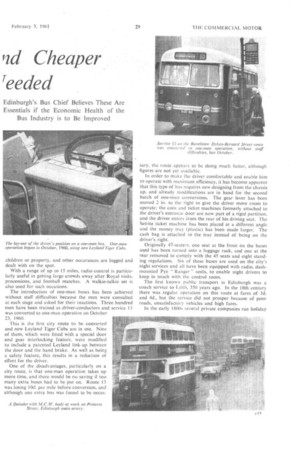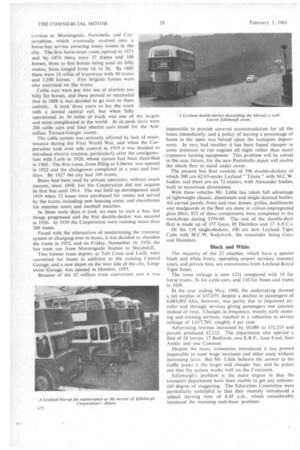Large% Buse, rid Cheaper reeded
Page 80

Page 81

Page 82

If you've noticed an error in this article please click here to report it so we can fix it.
by G. Duncan Jewell
LARGER and lighter buses in the Continental style, and reasonably priced bodies with a life of about five years, are two essentials if the economic health of the bus industry is to be improved.
This, is the belief of Edinburgh Corporation Transport's general manager, Mr. William Morison Little, B.Sc., A.M.1.C.E., A.M.I.E.E., M.Inst.T., who has already had considerable success in experiments with lightweight designs. With a fleet totalling 746 buses and coaches and a route mileage of over 123 miles, Mr. Little has already pushed economy to considerable lengths by the use of maximum-capacity and mininulm-weight buses, short-wave radio, one-man operation, and time-and-motion study.
The result is a compact and modern undertaking working at maximum efficiency in face of rising costs and a declining number of passengers.
Time study, instituted in 1955, resulted in a scheme of bonus-working for maintenance staff by 1956-57, each bus being allotted a team. Under a new pilot maintenance system at Longstone depot six buses are in at one period for 14 days overhaul, three being completed weekly. Complete chassis overhauls will eventually be eliminated and replaced by a system of unit maintenance with threeand nine-week docks.
Improved maintenance methods over the past five years have resulted in a conSiderable saving in staff. Car and bus cleaners have peen reduced from 246 to 96; fitters, etc., from 50 to 27; electricians and welders from 60 to 30; shedmen and garage hands from 253 to 184; and vehicle body workers from 208 to 178.
Short-wave radio was installed in 1953, starting with six sets monitored from the office of the traffic superintendent, Mr. W. C. Brown. When the transport department moved to their new head offices at 14 Queen Street, in 1957, a central control room was installed in the basement,
Highly trained inspectors are on duty day and night and the system is linked to the City Engineer's Department, including lighting and cleansing. The inspectors control the traffic vans, receive accident, weather and other reports, and have a complete minute-by-minute picture of bus operation throughout the 24 hours. Two patrol vans are on the road from 6 a.m. to midnight and are in constant touch with the control room; all reports of accidents, last children or property, and other occurances are logged and dealt with on the spot.
With a range of up to 15 miles, radio control is particularly useful in getting large crowds away after Royal visits. processions, and football matches. A walkie-talkie set is also used for such occasions.
The introduction of one-man buses has been achieved without stall difficulties because the men were consulted at each stage and asked, for their reactions. Three hundred men have been trained as driver-conductors and service 13 was converted to one-man operation on October 23, 1960.
This is the first city route to be converted and new Leyland Tiger Cubs are in use, Nine of them, which were fitted with a special door and gear interlocking feature, were modified to include a patented Leyland link-up between the door and the hand brake. As well as being a safety feature, this results in a reduction of effort for the driver..
One of the disadvantages, particularly on a city route, is' that one-man operation takes up more time, and there would be no saving if too many extra buses had to be put on. Route 13 was losing 10d. per mile before conversion, and although one extra bus was found to be neces sary, the route appears to be doing much better, although figures are not yet available.
In order to make the driver comfortable and enable him to operate with maximum efficiency, it has become apparent that this type of bus requires new designing from the chassis up, and already modifications are in hand for the second batch of one-man conversions. The gear lever has been moved 2 in. to the right to give the driver more room to operate; the coin and ticket machines formerly attached to the driver's entrance door are now part of a rigid partition, and the driver enters from the rear of his driving seat. The Setrite ticket machine has been placed at a different angle and the money tray (plastic) has been made larger. The cash bag is attached to the tray instead of being on the driver's right.
Originally 47-seaters. one seat at the front on the buses used has been turned into a luggage rack, and one at the rear removed to comply with the 45 seats and eight standing regulations. Six of these buses are used on the city's night services and all have been equipped with radio, dashmounted Pyc " Ranger" units, to enable night drivers to keep in touch with the control room.
The first known public transport in Edinburgh was a coach service to Leith, 350 years ago. In the 18th century there was regular operation on this route at fares of 3d. and 4d., but the service did not prosper because of poor roads, unsatisfactory vehicles and high fares.
In the early 1800s several private coMpanies ran holiday s2rvices to Morningside, Portobello and Corstorphine, which eventually evolved into a horse-bus service covering many routes in the city. The first horse-tram route opened in 1871 and by 1874 there were 37 trams and 100 horses, three to five horses being used on hilly routes; fares ranged from Id. to 3d. By 1880 there were 18 miles of tramways with 90 trams and 1,100 horses. Fire brigade horses were also exercised on the trams.
.Cable cars were put into use in districts too 'hill)/ for horses, and these proved so successful that in 1888 it was decided to go over to them entirely. It took three years to lay the track with a slotted central rail, but when fully operational its 36 miles of track was one of the largest and most complicated in the world. At its peak there were 200 cable cars and four electric cars (used for the Ardmillan Terrace-Gorgie route).
The cable system was seriously affected by lack of maintenance during the First World War, and when the Corporation took over sole control in 1919 it was decided to introduce electric traction, particularly after the amalgamation with Leith in 1920, whose system had been electrified in 1905. The first route, from Pilrig to Libcrto, was opened in 1922 and the changeover completed in a year and four days. By 1927 the city had 349 trams.
Buses had been used by private operators, without much success, since 1898, but the Corporation did not acquire its first bus until 1914. The war held up development until 1919 when 12 buses were purchased for routes not served by the trams, including new housing areas, and charabancs for summer tours and football matches.
In those early days it took six men to start a bus, but things progressed and the first double-decker was secured in 1926. In 1939 the Corporation were running more than 200 buses.
Faced with the alternatives of modernizing the tramway system or changing over to buses, it was decided to abandon the trams in 1952, and on Friday, November 16, 1956, the last tram ran from Morningside Station to Shrubshill.
Two former tram depots, at Toll Cross and Leith, were converted for buses in addition to the existing Central Garage, and a new depot on the west side of the city, Longstone Garage, was opened in October, 1955. Because of the £2 million tram conversion cost it was impossible to provide covered accommodation for all the buses immediately, and a policy of leaving a percentage of buses in the open was forced upon the transport department. In very bad weather it has been found cheaper in some instances to run engines all night rather than instal expensive heating equipment. This problem will be solved in the near future, for the new Portobello depot will enable the whole fleet to stand under cover.
The present bus fleet consists of 596 double-deckers of which 300 are 62/63-seater Leyland " Titans " with M.C.W. bodies, and there are six 72-seaters, with Alexander bodies, built to maximum dimensions.
With these vehicles Mr. Little has taken full advantage of lightweight chassis, aluminium and single-skinned bodies. All curved panels, front and rear domes, grilles, dashboards and mudguards in the fleet are done in colour-impregnated glass fibre; 832 of these components were completed in the workshops during 1959-60. The rest of the double-deck fleet is made up of 157 Guys, 85 Daimlers and 17 A.E.C.s.
Of the 118 single-deckers, 100 are new Leyland Tiger Cubs with M.C.W. bodywork, the remainder being Guys and Daimlers.
Black and White The majority of the 22 coaches, which have a special black and white livery, operating airport services, summer tours, and private hire, are conversions from Leyland Royal Tiger buses, The route mileage is now 123-1compared with 18 for horse trains, 36 for cable cars. and 110 for buses and trams in 1939. .
In the year ending May, 1960, the undertaking showed a net surplus of £47,659, despite a decline in passengers of 6,684,984 (this, however, was partly due to improved circular and through services giving passengers one journey instead of two). Changes in frequency, mainly early morning and evening services, resulted in a reduction in service mileage of 1,017,769, roughly 4 per cent.
Advertising revenue increased by £6,086 to £31,215 and parcels produced £2,122. The department also operate a fleet of 28 lorries, 17 Bedfords, two E.R.F., four Ford, four Austin and one Commer.
Despite the many economies introduced it has proved impossible to meet wage increases and other costs without increasing fares. But Mr. Little believes the answer to the traffic peaks is the larger and cheaper bus, and he points out that the system works well on the Continent.
Edinburgh's problem is the more -urgent in that the transport department have been unable to get any substantial degree of staggering. The Education Committee were particularly unhelpful in that they recently introduced a school starting time of 8.45 a.m., which considerably increased the morning rush-hour problem.
































































































































